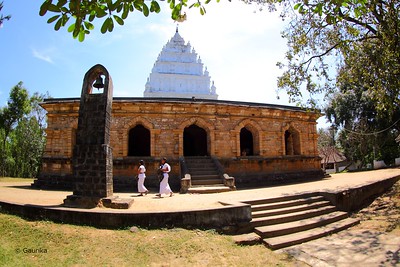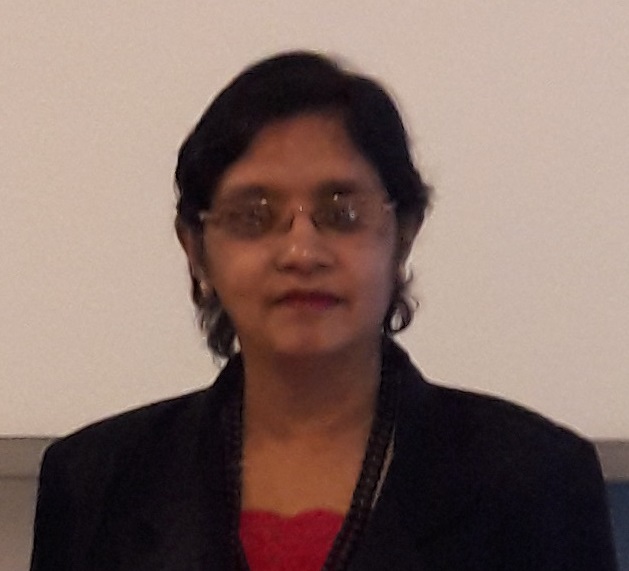Galmaduwa Viharaya – extraordinary building of unique architecture
– By Arundathie Abeysinghe

Photo By Gaurika Wijeratne
 Situated in Nattaramapotha (traditional craft village in Kandy) in Kundasale approximately 14 kilometers from Kandy City, Galmaduwa Viharaya is an extraordinary building of unique architecture. The Temple is an incomplete structure traditionally ascribed to King Keerthi Sri Rajasinghe’s era (1747- 1782).
Situated in Nattaramapotha (traditional craft village in Kandy) in Kundasale approximately 14 kilometers from Kandy City, Galmaduwa Viharaya is an extraordinary building of unique architecture. The Temple is an incomplete structure traditionally ascribed to King Keerthi Sri Rajasinghe’s era (1747- 1782).
The structure of the Temple has a Tamil-Hindu influence, although it is a Buddhist place of worship. Constructed of stone and brick with a high gopuram (monumental tower, usually ornate at the entrance of a temple, a feature prevalent in South India), it is the only temple in Sri Lanka with Tamil-Hindu influence within a Buddhist place of worship.
The incomplete stone temple that combines Buddhist and Hindu architectural features is an edifice that displays the excellence of massive stone and brick masonry that existed during the *Kandyan Kingdom. Although, it is an incomplete structure, it is a magnificent building.
Galmaduwa Viharaya is entwined in myths and legends. King Kirti Sri Rajasinghe had brought a plan from North India and constructed the Temple with the assistance of Meegasthanne Adikaram (also known as “Adigar” – a Great Officer with authority).
According to chronicles, while this building was being completed, King Keerthi Sri Rajasinghe heard of the discovery of a cave at Degaldoruwa and stopped construction of Galmaduwa Viharaya and diverted his attention to *Degaldoruwa Temple. Hence, to date, the Temple is incomplete and was never utilized as a temple (except some places of worship within the Temple Complex that were constructed recently).
The lower story of the *Mandapaya is constructed out of stone and the upper floors are constructed out of (mud) bricks, stone and granite. As the pavilion is made of gal (meaning stones in Sinhala), scholars are of the view that the name “Galmaduwa” (meaning stone structure, maduwa meaning hut/structure in Sinhala) was utilized.
In the interior of the pavilion, there is an Aasana (Image Altar). The pavilion is surrounded by a huge wall with an overhanging and deeply molded cornice. Salient features of the interior are the five windows pierced into the walls on three sides. Near the eastern building, there is a temple constructed approximately 125 years ago. As the villagers were unable to raise funds to complete the main temple, they had constructed a temple to compensate for the incomplete structure. The Image House in Galmaduwa Viharaya houses a marble seated Buddha Statue along with 24 other Buddha Statues dating to the Kandyan Era.
According to scholars, the old bricks engraved with *Brahmi script that were found in the temple premises prove that there had been an ancient stupa (dagoba) at this site. Reports written by British civil servants who served in *Ceylon during 19-20th centuries and folklore are the authentic reports about Galmaduwa Viharaya.
A.C Lawrie, an eminent British District Judge of Kandy (1873-92) has mentioned about Galmaduwa Viharaya in his book Gazetteer of the Central Province of Ceylon (originally published in 1896) and refers to the Temple as “Galmaduwa Gedige Vihare” or “Galapita-ambe Vihare”. He has described the Temple as “a very curious building built in the style of a Tamil Hindu temple.”
According to J.P Lewis, a well-known amateur historian who lived in Sri Lanka in the early 1900s, “the Galmaduwa Viharaya probably enjoys the unique distinction of being the most Hindu-looking Buddhist temple in existence”.
Describing its architectural features, Lewis has disclosed that “The central building is surrounded by a massive wall with an overhanging and deeply molded cornice, the outer wall is pierced on three sides by five windows; on the fourth which is on the west side, the place of the central window is taken by a doorway of slightly larger dimensions. The distance between the central building and the outer wall according to rough measurement is 14 feet. The former is 29 feet, the latter 16 feet square. There are but two doorways, one into the enclosure and one opposite it into the sanctum. They are each 6 feet wide, the windows 4 1/2 feet. The thickness of the outer wall is 3 ¼ feet, not including the moldings of the wall of the sanctum 3 feet.”
According to Lewis “The most interesting feature about this building is the shape of the arches of the doorways and the windows. They are semi-circular cusped arches with a keystone.”
Location: Nattarampota, Kundasale
- Brahmi inscriptions – The earliest writing system developed in India after the Indus script and considered as an influential writing system. All modern Indian scripts as well as several hundred scripts that are in South Asia, Southeast and East Asia are derived from Brahmi inscriptions.
- Ceylon – Sri Lanka gained Independence from British Colonials in 1948. In 1972, Ceylon became a republic within the Commonwealth and Ceylon was thereafter known as Sri Lanka.
- Kandyan Kingdom – A monarchy of Sri Lanka, located in the central part of the island founded in the late 15th century and endured until the early 19th century. Kandyan period covers the history of Sri Lanka from 1597–1815. After the fall of the Kingdom of Kotte, Kandyan Kingdom was the last independent monarchy of Sri Lanka and played a major role throughout the history of Sri Lanka. The Kingdom managed to remain independent from both the Portuguese and Dutch rule (who controlled coastal parts of Sri Lanka). Yet, it was colonized by the British Colonials in 1815 until Sri Lanka gained Independence in 1948.
- Mandapaya – Also known as “Maduwa” is a pillared structure with a roof above, open on all sides and protects people inside from sun and rain.
Degaldoruwa Cave Temple – vibrant ancient Kandyan art
By Arundathie Abeysinghe
Jan 7, 2023







